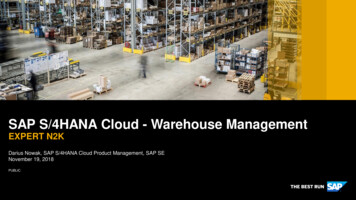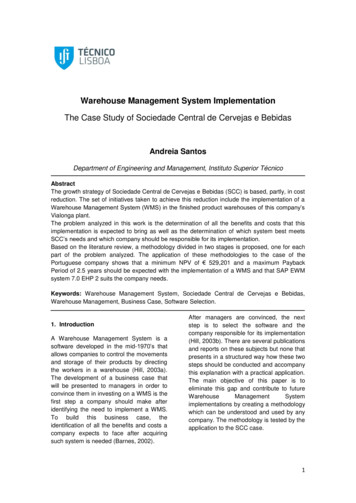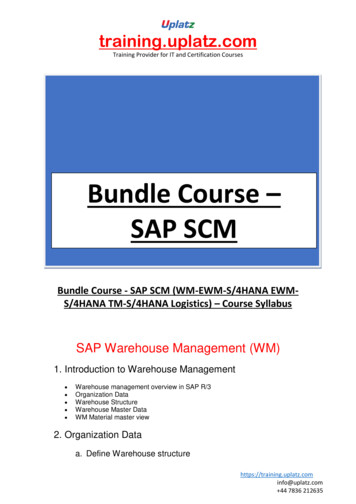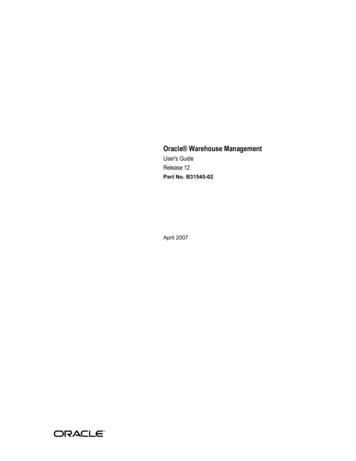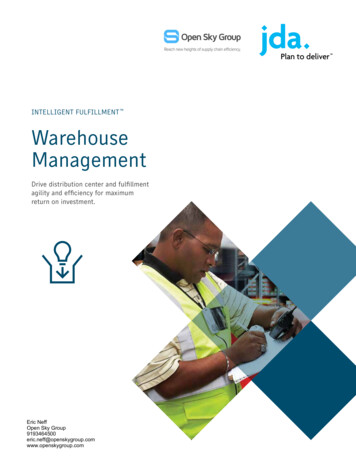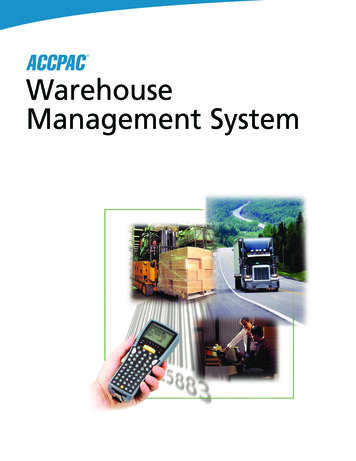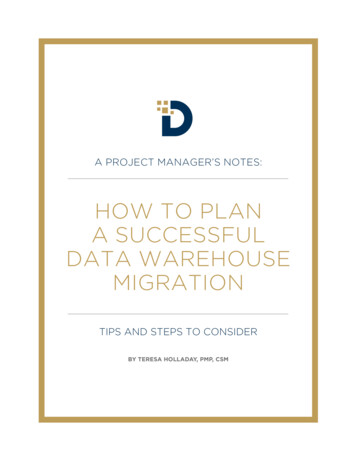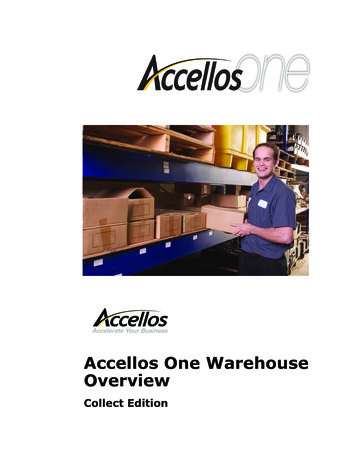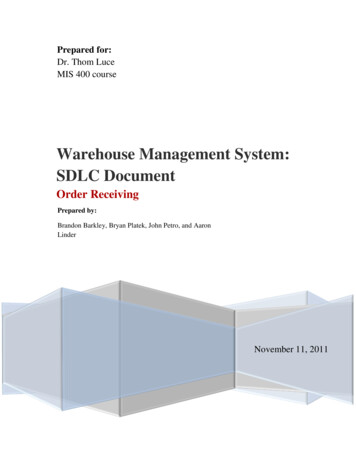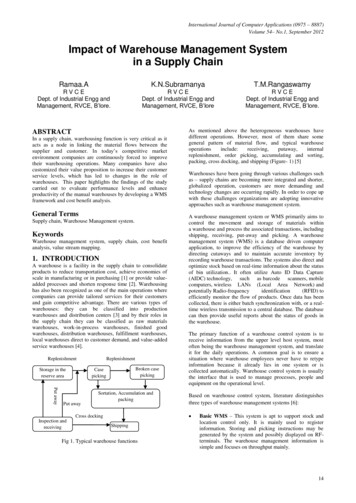
Transcription
International Journal of Computer Applications (0975 – 8887)Volume 54– No.1, September 2012Impact of Warehouse Management Systemin a Supply ChainRamaa.AK.N.SubramanyaT.M.RangaswamyRVCEDept. of Industrial Engg andManagement, RVCE, B’lore.RVCEDept. of Industrial Engg andManagement, RVCE, B’loreRVCEDept. of Industrial Engg andManagement, RVCE, B’lore.ABSTRACTIn a supply chain, warehousing function is very critical as itacts as a node in linking the material flows between thesupplier and customer. In today’s competitive marketenvironment companies are continuously forced to improvetheir warehousing operations. Many companies have alsocustomized their value proposition to increase their customerservice levels, which has led to changes in the role ofwarehouses. This paper highlights the findings of the studycarried out to evaluate performance levels and enhanceproductivity of the manual warehouses by developing a WMSframework and cost benefit analysis.General TermsSupply chain, Warehouse Management system.KeywordsWarehouse management system, supply chain, cost benefitanalysis, value stream mapping.1. INTRODUCTIONA warehouse is a facility in the supply chain to consolidateproducts to reduce transportation cost, achieve economies ofscale in manufacturing or in purchasing [1] or provide valueadded processes and shorten response time [2]. Warehousinghas also been recognized as one of the main operations wherecompanies can provide tailored services for their customersand gain competitive advantage. There are various types ofwarehouses: they can be classified into productionwarehouses and distribution centers [3] and by their roles inthe supply chain they can be classified as raw materialswarehouses, work-in-process warehouses, finished goodwarehouses, distribution warehouses, fulfillment warehouses,local warehouses direct to customer demand, and value-addedservice warehouses [4].ReplenishmentStorage in thereserve areaReplenishmentBroken casepickingCasepickingPut awayPut awaySortation, Accumulation andpackingWarehouses have been going through various challenges suchas – supply chains are becoming more integrated and shorter,globalized operation, customers are more demanding andtechnology changes are occurring rapidly. In order to cope upwith these challenges organizations are adopting innovativeapproaches such as warehouse management system.A warehouse management system or WMS primarily aims tocontrol the movement and storage of materials withina warehouse and process the associated transactions, includingshipping, receiving, put-away and picking. A warehousemanagement system (WMS) is a database driven computerapplication, to improve the efficiency of the warehouse bydirecting cutaways and to maintain accurate inventory byrecording warehouse transactions. The systems also direct andoptimize stock based on real-time information about the statusof bin utilization. It often utilize Auto ID Data Capture(AIDC) technology, such as barcode scanners, mobilecomputers, wireless LANs (Local Area Network) andpotentially Radio-frequencyidentification(RFID) toefficiently monitor the flow of products. Once data has beencollected, there is either batch synchronization with, or a realtime wireless transmission to a central database. The databasecan then provide useful reports about the status of goods inthe warehouse.The primary function of a warehouse control system is toreceive information from the upper level host system, mostoften being the warehouse management system, and translateit for the daily operations. A common goal is to ensure asituation where warehouse employees never have to retypeinformation because it already lies in one system or iscollected automatically. Warehouse control system is usuallythe interface that is used to manage processes, people andequipment on the operational level.Based on warehouse control system, literature distinguishesthree types of warehouse management systems [6]: Cross dockingInspection andreceivingAs mentioned above the heterogeneous warehouses havedifferent operations. However, most of them share somegeneral pattern of material flow, and typical nalreplenishment, order picking, accumulating and sorting,packing, cross docking, and shipping (Figure- 1) [5]ShippingFig 1. Typical warehouse functionsBasic WMS – This system is apt to support stock andlocation control only. It is mainly used to registerinformation. Storing and picking instructions may begenerated by the system and possibly displayed on RFterminals. The warehouse management information issimple and focuses on throughput mainly.14
International Journal of Computer Applications (0975 – 8887)Volume 54– No.1, September 2012 Advanced WMS – Above the functionality offered by abasic WMS, an advanced WMS is able to plan resourcesand activities to synchronize the flow of goods in thewarehouse. The WMS focuses on throughput, stock andcapacity analysis. Complex WMS – With a complex WMS the warehouseor group of warehouses can be optimized. Information isavailable about each product in terms of where it islocated (tracking and tracing), what is its destination andwhy (planning, execution and control). Further, acomplex system offers additional functionality liketransportation, dock door, and value added logisticsplanning which help to optimize the warehouseoperations as a whole.Warehouse management systems can be stand alone systemsor modules of an ERP (Enterprise Resource Planning) systemor supply chain execution suite. The primary purpose of aWMS is to control the movement and storage of materialswithin a warehouse. The WMS can be deployed as a paperbased, RF/wireless based or combination of both.2. LITERATURE REVIEWWarehousing takes up to between 2% and 5% of the cost ofsales of a corporation [7] and with today’s highly competitiveglobal business environment organizations are emphasizingon Return on Assets, and hence minimizing warehousingcosts has become an important business issue. Many firms areautomating their basic warehousing functions to achieve theincrease in throughput rates or inventory turns required fortheir warehousing operations to be cost effective.It is necessary to allocate warehouse resources efficiently andeffectively to enhance the productivity and reduce theoperation costs of the warehouse [8]. One vital areadetermining the efficiency of warehouse is the determinationof the proper storage locations for potentially thousands ofproducts in a warehouse. Various factors affecting the storageassignment like order picking method, size and layout of thestorage system, material handling system, productcharacteristics, demand trends, turnover rates and spacerequirements are been extensively studied. It has beensuggested that selecting appropriate storage assignmentpolicies (i.e. random, dedicated or class-based) and routingmethods (i.e. transversal, return or combined) with regards toabove factors is a possible solution to improve the efficiency[9]. Various decision support models and solution algorithmshave also been established to solve warehouse operationplanning problems [10].The use of information systems for warehouse management isstudied extensively in literature. Complexity of warehousemanagement is indicated among others by amount andheterogeneity of handled products, the extent of overlapbetween them, amount and type of technology as well ascharacteristics of associated processes. As the complexityincreases it becomes necessary to use Warehousemanagement systems for handling warehouse resources and tomonitor warehouse operations. The warehouses with a highamount of processed order lines and amount of stock keepingunits will be best supported by customized software. It isdifficult to update daily operations of inventory level,locations of forklifts and stock keeping units (SKUs) in realtime by using the bar-code-based or manual-based warehousemanagement systems [6].RFID technology is adopted to facilitate the collection andsharing of data in a warehouse. Tests are performed forevaluating the reading performance of both the active andpassive RFID apparatus. Implementing RFID technologiesrequires a thorough cost and benefit analysis ofimplementation. The costs of RFID implementation includetag reader costs, communication costs and other infrastructurecosts. RFID can improve the automatic checkout process at aretail store, so it can reduce inventory costs as a result of moreefficient shelf replenishment. RFID technologies can supportthe redesign of business processes; improve data quality; realtime data collection; synchronization and information sharingbetween the players of supply chain [10]. RFIDimplementation can also bring about additional benefits suchas reduction losses due to shop lifting and increased use ofpoint of sale applications [11].Implementation of Warehouse Management System (WMS)will necessarily provide an increase in accuracy, reduction inlabor costs if the labor employed to maintain the system isless than the labor saved on the warehouse floor and a greaterability to service the customer by reducing cycle times. WMSwill not only lead in inventory reduction but also in greaterstorage capacity. An increase in accuracy and efficiency of thereceiving process might lead to reduction in level of safetystock required. But the consequence of this reduction willhardly be visible to the overall inventory levels. WMS mightjust not affect the factors (lot sizing, lead times and demandvariability) controlling the inventory levels. However WMS isinstrumental in more efficient and organized that leads toincreased storage capacity [8].The implementation of WMS for a company demandssignificant investment and time period (several months) whichhas to be justified with the benefits obtained afterimplementation. The justification involves the excellentanalysis of the current situation of the warehouse andwarehouse operation for a specific period of time tuning theWMS. The firm should be prepared to change the entireprocess and system storage. Only WMS implementationswithout changing processes show that does not lead to costsavings or efficiency improvements, it will only reduce errorsdue to human factors.3. WAREHOUSEMEASUREMENTPERFORMANCEMeasuring warehouse metrics is critical for providingmanagers with a clear vision of potential issues andopportunities for improvements. Metrics are tied directly tothe business strategy and operation’s success drives thefinancial results of the organization. If warehouses are goingto contribute to be a source for adding value to the supplychain then they need to measure their performance withperfect metrics.The metrics for measuring performance in a warehouse fallinto three main categories which includes order fulfillment,inventory management and warehouse productivity.The establishment of metrics for auditing warehouseperformance and assessment of WMS potential as a basis forinvestment justification should be the first steps in any WMSproject [13]. The identification of proper metrics andopportunities for improvement can be a preliminaryjustification to determine potential payback [14]. Thefollowing metrics supplements the above process.15
International Journal of Computer Applications (0975 – 8887)Volume 54– No.1, September 2012Table 1 – Performance Metrics of a nt uracyLineaccuracyOrder magedinventoryStorageutilizationDocktostock hourperLineshourperItemshourperCostorderperCost as a %of salesDefinitionOrders delivered on timeper customer requested dateOrders filled completely onfirst shipmentOrder picked, packed andshipped perfectlyLines picked, packed andshipped perfectlyTime from order placementto shipmentOrders delivered withoutchanges, damage or invoiceerrors.Actual inventory quantity tosystem- reported quantityDamage measure as a % ofinventory valueOccupied space (squarefootage) as a % of storagecapacity (square footage)Avg. time from carrierarrival until product isavailable for order pickingTime from physical receiptto customer service noticeof availabilityAvg. number of orderspicked and packed perperson - hourAvg. number of orders linespicked and packed perperson – hourAvg. number of ordersitems picked and packed perperson – hourTotal warehousing costs –Fixed: space, utilities anddepreciationVariable: labor / suppliesTotal warehousing cost as apercent of total companysales.4. CASE STUDYThe study was conducted at India’s biggest retail company,which has developed expertise in Supply Chain Managementof consumer product categories such as Fashion, Food andGeneral Merchandise. The company operates from 60strategically located hubs, servicing more than 2600 retailoutlets spread across the length and breadth of India. Itsnetwork of facilities and specialized expertise enable it tomanage more than 3 million SKUs per year. This requires 30distinct supply chains to be managed simultaneously, eachwith their own specific requirements that require customizedsolutions.Out of the three warehouses where the study was taken up,one had automated WMS and the other two warehouses weremanually run and had a high cycle time of 773 minutes. Theretail chain company possessed three more warehouses whichwere catering to a total of 14 stores across south India. Withthe company planning to add more stores and establish acentralized warehouse this chain would become inefficient. Inorder to improve the efficiency a study was taken to analysethe impact of implementation of WMS in these warehouses.The study began with the understanding the current state ofoperations of the warehouses. Value stream maps were usedfor the same. Value Stream Mapping is the simple process ofdirectly observing the flow of information and material asthey occur and summarizing them visually. A Value Streaminvolves all of the steps, both value added and non-valueadded, required to bring a product or service through theprocess steps. It is a visual tool used to help see the hiddenwaste and sources of waste. A Current State Map is drawn todocument how things actually operate (this is the “as-is”process). Then, a Future System Map (how it should be) isdeveloped to design a lean process flow through theelimination of the root causes of waste and through processimprovements all leading to an implementation The currentvalue stream map used in the study is as shown in figure 2.In these warehouses, the goods were received in bulk and putaway in racks. On the receipt of order, articles were picked,packed and dispatched. The process was tedious to carry outas no WMS was available. Though scanners were used forGoods Receipt Note in these warehouses, it was stillconsidered a manual warehouse. Many vendors providinggoods for the warehouse were still sending the goods directlyto the stores then to the warehouse owing to the infrastructureand capacity constraints. This greatly increases the logisticscost involved.The current process had a cycle time of 773 minutes of which537 minutes was non-value added time. A lot of time waswasted as the supplier had to wait about an hour before theunloading can take place. There was no system to scheduletime for the arrival of vehicles. Since a flow through processwas followed the goods were to be stored on the floor till theywere dispatched. Amount of goods that can be stored directlycorresponds to the total floor space available. The cubicalspace was not effectively utilized. Minimal racking wasavailable to store “return to vendor goods”. With limitedavailable infrastructure it was difficult to track and retrievethese items.The future state value stream map is drawn incorporatingWMS, Put –to –light system and racking stackinginfrastructure and is shown in figure 3. As shown in the mapthe cycle time of the process reduces to 236 minutes. The nonvalue added time reduces to 95 minutes. The manpowerrequired is reduced by 40 percent. The process wiseimprovements are shown in the table 2Table 2. Performance Improvements at Warehouse afterWMS ImplementationProcessTime Savings perOrder (in mins)ProcessImprovement aging3568.62Dispatch42494.216
International Journal of Computer Applications (0975 – 8887)Volume 54– No.1, September 2012Average Waiting Time: 1hourFIFOUnloading StaffUnloading ProcessSuppliersNo. of Workers: 3Average Time Taken: 10 minsProof ofDeliveryPurchase OrderLogistic ProvidersManual IRNReceiving StaffStoresOutbound StaffAverage Time Taken: 45mins-1 hourNo. of Workers: 2No. of Sheets of Paper: 1IRNConfirmationVehicle AppointmentManual GRNQueue for SortingAverage Time Taken: 1hrNo. of Workers: 3No. of Sheets of Paper: 1FIFOShippingDocumentsPacketManual Sorting AreaWorkers per Zone: 3Total workers: 9Visual Observationto checkDispatch QuantitiesTime Taken per Case: 25 Mins10Mins16Mins100 MinsSorting Zone IIPick ListWait for DispatchSorting Zone IIINo. of Sheets of Paper: 10-25Sorting Zone INo. of Workers: 6Average Time per Shipment(400Boxes): 80 MinsNo. of Sheets of Paper: 660 MinsNo of Sorting Zones: 3Pick ListExcel Sheet for SortingOutbound Process150 Mins80 Mins180 Mins177 MinsNon- Operation Time: 537MinsOperation Time: 236 MinsTotal Time Taken: 773 Mins. Fig 2: Current state of the warehouseWaiting Time: 0 MinsUnloading StaffUnloadingProcessSuppliersNo. of Workers: 3Average Time Taken: 10minsLogistic ProvidersAppointmentSchedulingAdvance ShipmentNo.StoresReceiving StaffCubingVehicle AppointmentData Manually FedLANE IDAverage Time Taken: 15MinsNo. of Workers: 1No. of Sheets of Paper:1Boxes Married to Pallet and LaneHHT Supported IRNAverage Time Taken: 20 MinsNo. of Workers: 2No. of Sheets of Paper: 0DispatchNo. of Workers: 4Average Time perShipment(400 boxes): 20MinsNo. of Sheets of Paper: 6HHT Supported GRNAverage Time Taken: 30 MinsNo. of Workers: 3No. of Sheets of Paper: 0STORE LANESPut To Light Sortation SystemQueue for DispatchOutbound StaffValue added timeNon value added time139 mins95 minsLoad ID MappingNo of Sorting Bays: 2Workers per Bay: 1Total workers: 2Time Taken per Case: 3 MinsNo. of Sheets of Paper: 0No. of Workers: 2Average Time perShipment(400 Boxes): 10 MinsNo. of Sheets of Paper: 038 mins28 mins10 mins21 mins22 mins42 mins19 mins44 minsFig 3: Future state of the warehouse17
International Journal of Computer Applications (0975 – 8887)Volume 54– No.1, September 2012 4.1 Performance ImprovementsApart from the tangible benefits listed above there are manyintangible benefits of implementing the WMS. Some theperformance improving benefits are listed below: With WMS, time scheduling of vehicle is possible. Thisreduces the waiting of the supplier.With Advanced Shipment Note enabling the warehousehas prior information about the goods it is about toreceive.WMS assisted put-away of goods is now possible.100 percent goods traceability. With RF infrastructure inplace the goods can be pin pointed to exact their location.Algorithm based picking simplifies picking operation.Auto updating of information prevents manual data entryand also reduces error rates.With many reports that can be generated decision makingis assisted.Processing one order requires 19 sheets in a manualsystem while with WMS the paper consumption perorder reduces to 4 sheets.The table 3 shows a comparison of WMS to Non WMSwarehouse in terms of performance metrics adoption.Table 3 Comparison of WMS / Non-WMSPERFORMANCE METRICS1.ReceivingAppointment SchedulingDock SchedulingIs it ASN enabled scheduling?2.Put-awaySpace AllocationIf Batch wise allocation, FEFOconcept possible3.PickingPick AccuracyPicking SequenceWhether opportunity to clusterpick4.Overall 0/day97Table 4: Initial Investment BreakupSoftware Licensing FeeRadioFrequencyInfrastructure:Server and Workstations:Hand Held Terminals:Rs. 30,00,000(Rs. 1,50,000 per user/ 3 years* 20 users)Rs. 20,00,000Rs. 20,00,000Racking:Rs. 60,00,000(Rs. 80,000/terminal Rs.20,000 for AMC/ terminal *60 users)Rs. 1,00,00,000Consultants:Rs. 20,00,000Training costs:Rs. 10,00,000Pallet Trucks:Pick to Light System:Rs. 40,00,000(Rs. 13,00,000* 3 Trucks)Rs. 1,00,00,000Total Investment:Rs. 4,10,00,000The Initial Investment bears equal distribution during the 6month phase. The cash flow diagram below shows 000/day574.2 Cost Benefit AnalysisThe cost- benefit analysis for implementation of WMS in oneof the warehouse is done. This was done by estimating the NetPresent Value of the savings. The initial investment breakupfor implementing WMS is as shown in table 4Assumptions: ExpensesNon WMSNo Transportation prices is assumed to increase by 10%once in the time horizonCost figures may have a deviation of 10-15 percent thanthat of actual figuresLosses incurred during implementation are Rs. 10,00,000Implementation period is assumed to be 6 monthsCapital is borrowed at an interest rate of 10% for aperiod of 2 yearsFig 4. Cash flow diagram of the expensesKey SavingsThe tangible savings due to implementation of WMS are: consolidation of warehousesmanpower layoffThe initial savings are due to shut down of warehouses.Currently there are four Factory warehouses one each inHyderabad, Vijayawada, Vishakhapatnam and Bangalore. Acentral warehouse in Bangalore can be used to cater to allstores in South India when WMS is implemented. With acentral warehouse in place there is no requirement for theother three warehouses which can be closed down. Once theconsolidation of all the warehouses is complete the manpoweris gradually reduced.18
International Journal of Computer Applications (0975 – 8887)Volume 54– No.1, September 2012The manpower reduction is assumed to be about 40 percent.The layoff is done over a period of four months. Once thisprocess is complete the savings reach its peak. Now there isslight increase in transportation cost as goods have to be sentfrom Bangalore to other states as well. Thus there is a smalldip in savings from the 18th month. This conservativeestimate shows that the payback period is about 36 monthsand net savings of Rs. 19,60,000.The analysis shows benefits exceed the investments. WMSimplementation is a capital investment. It takes some time tobreak even. But strategically it offers premium advantage tothe company.customer service levels, lead times, and the cost structure of acompany. Hence we can conclude that warehousinginfluences the performance of an entire supply chain.With the boom in organized retailing it becomes necessary forthe players to continuously improve their process. Theretailers have to strive continuously to reduce their costs.Technology being an enabler improved technology has to beincorporated into the current processes. Also the processeshave to be designed in such a way that they provide forincorporating changes.The value stream mappings of the current systems showedmany bottlenecks that prevail in the system. These bottlenecksrestricted the capacity the warehouses could handle.Performance and productivity of the warehouse suffered asthe operations were manually carried when it could be moreeasily and more effectively done using machines. With WMSimplementation the cycle time of the process also decreases.The cycle time reduces from 773 minutes to 236 minutes Thecost benefit analysis for WMS implementation in warehouseshows a savings of Rs. 19,60,000 per month. The studyproves WMS to be an enabling factor for performance andproductivity improvement. The productivity of a WMSwarehouse is way higher than when the operations aremanually performed.6. ACKNOWLEDGMENTSFig 5. Cumulative Flow Diagram of Savings after WMSimplementationThe net cash flow diagram showing both expenses andsavings is given below.We would like to thank our students Rishabh Shah, Sandeep,Niranjan and Bopanna who have contributed to this research.Also thank the company for providing us the opportunity toconduct the study.7. REFERENCES[1] Bartholdi III JJ, Hackman ST (2006), Warehouse anddistribution science. www.warehouse-science.com[2] Gong Y, De Koster MBM (2008), A polling-baseddynamic order picking system for online retailers. IIETransactions 40 pages:1070–1082[3] Ghiani G, Laporte G, Musmanno R (2004), Introductionto Logistics Systems Planning and Control. John Wiley& Sons, England[4] Frazelle E (2001), World-class warehouseing andmaterial handling. McGraw-Hill, New York[5] Tompkins JA, White JA, Bozer YA, Frazelle EH,Tanchoco JMA (2003), Facilities planning. John Wiley& Sons, NJ[6] Faber, Nynke; De Koster, Rene B. M. (2002), Linkingwarehouse complexity to warehouse planning andcontrol structure: An exploratory study of the use nal Journal of Physical Distribution & LogisticsManagement [online]. vol. 32,(5), pages. 381 – 395Fig 6. Net Cash Flow Diagram of a WMS implementation5. CONCLUSIONAs an impact of large product varieties and shortenedcustomer response times there is a greater emphasis on theability of the organizations to establish smooth and efficientlogistics operations. In this regard, warehouses play a vitalrole because they function as nodes that direct the flow ofmaterials within a distribution network. The effects oforganizing warehousing activities can directly be seen in[7] Heung Suk Hwang, Gyu Sung Cho (2006), Aperformance evaluation model for order pickingwarehouse design, Computers & Industrial EngineeringVol. 51(2), pages: 335-342.[8] T.C. Poon, K.L. Choy, Harry K.H. Chow , Henry C.W.Lau, Felix T.S. Chan, K.C. Ho (2009), A RFID casebased logistics resource management system formanaging order-picking operations in warehouses,Expert Systems with Applications, Vol. 36(4), pages8277-830119
International Journal of Computer Applications (0975 – 8887)Volume 54– No.1, September 2012[9] Felix T.S. Chan, H.K. Chan (2011), Improving theproductivity of order picking of a manual-pick and multilevel rack distribution warehouse through theimplementation of class-based storage, Expert Systemswith Applications, Vol. 38(3), pages 2686–2700.[10] Jinxiang Gu, Marc Goetschalckx, Leon F. McGinnis(2007), Research on warehouse operation: Acomprehensive review, European Journal of OperationalResearch, Vol. 177(1), pages 1–21.[11] S.F. Wamba, T.R. Coltman, and K. Michael (2008).RFID-Enabled warehouse optimisation: Lessons fromearly adopters in the 3PL industry. ICIS Ancillarymeeting, Paris, France, pages 1-12.[12] J. Sounderpandian, R. V. Boppana, S. Chalasani, and A.M. Madni. (2007) Models for cost-benefit analysis ofRFID implementations in retail stores. IEEE SystemsJournal, Vol(1), pp105-114,.[13] Chris Caplice and Yossi Sheffi (1995), A review andevaluation of logistics performance measurementsystems, The International journal of LogisticsManagement, Vol. 6(1), pages 61-74.[14] John M Hill (2002), Justifying warehouse managementsystems, white paper, ESYNC.20
A warehouse management system or WMS primarily aims to control the movement and storage of materials within a warehouse and process the associated transactions, including -away and picking. A warehouse management system (WMS) is a database driven computer application, to improv

